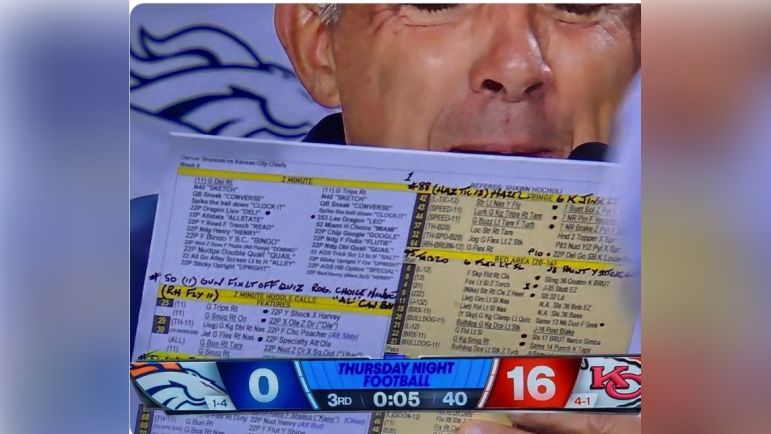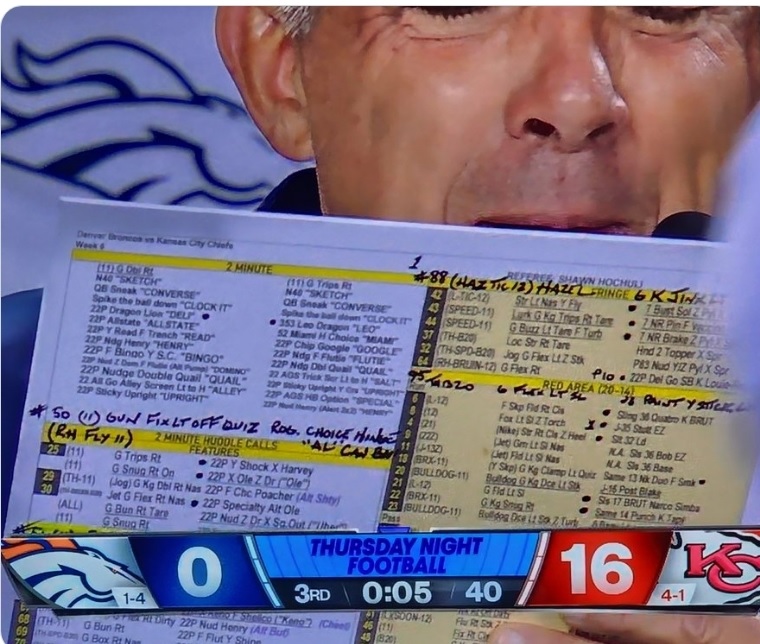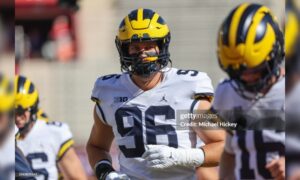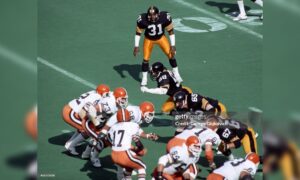No, this isn’t directly Pittsburgh Steeler’s related. But with the team off this week, we can branch out a bit and talk about a larger point. Given how much criticism has gone OC Matt Canada’s way, it’s also a worthwhile moment to talk about how an NFL offensive call sheet is made and what it all means.
During Thursday night’s game between the Denver Broncos and Kansas City Chiefs, the Amazon production crew had a close-up on Broncos’ head coach Sean Payton, also the team’s offensive playcaller. For Payton, it was probably a little too close. The back of his playsheet was entirely visible and legible and gives us the chance to see all of his calls and what that side of the sheet looks like.
Here it is.
Obviously, there’s a lot there. Off the top, it’s a reminder of how big a playsheet can be. Keep in mind this might not be the entire playbook but the plays from it they selected to run in this game.
If you look at the yellow highlighted portions of the sheet, you can see it’s broken down by area of the field and game circumstance. Plays aren’t called at random. They’re situational. Based on what concepts work better in some areas of the field than others (you can’t run four verticals near the goal line, for example) and based on the defense’s personality and what coverages they like to play in certain situations.
On Payton’s playsheet, you can see it’s broken down by: 2 Minute, 2 Minute Huddle Calls, Fringe, and Red Area, which is then broken down into pass and run plays. What do each mean? Let’s break it down.
2 Minute – These are the teams no huddle plays. That’s why they’re 2 Minute and 2 Minute “Huddle Calls” where they would be huddling after, say, an incompletion or play out of bounds. The 2 Minute Calls have the full play spelled out with one word next to them. Why? Because in a no-huddle situation, you’re quickly trying to get the play in without overloading with information. One word will tell you the whole play to quickly get that information to the QB so he can tell the offense. So 22P Dragon Lion becomes “Deli.” Much shorter and quicker. Also, 22P is the protection, not the personnel. You also get the fun “Converse” for QB sneak. Nothing wrong with a little shoe pun.
Some of the playcalls are shortened even further in two-minute. AGS HB Option just becomes “Special.” Where does that come from? Because AGS stands for “All Go Special” which is basically a four-vertical concept with the HB’s route tagged. We actually detailed an All Go Special in the Steelers’ playbook.
Finally, if you look closely enough, you might notice that quadrant has some of the same plays listed twice. Why? At the top of each column, you can see them separated by ‘G Dbl Rt” and “G Trips Rt.” Those signify the formation. “Dbl Rt” are 2×2 formations while “Trips Rt” are 3×1 formations. And sometimes they have the same plays out of them, at least basic stuff like QB sneaks and spikes.
2 Minute Huddle – The huddle calls for two minute. Longer calls that can be called in a huddle where it’s easier to communicate more information like that. As for the numbers to the left, the 25, 29, etc? I’m a little less sure of and if anyone else wants to chime in, feel free. My belief is those would be the plays on the QB’s wristband he could look to to more quickly get in a call or if he doesn’t hear every word from the playcaller, so long as he hears “25” he knows which play. But I could be wrong.
And these all look to be one long call that set formation and then the actual play: So “G Trips Rt 22P Y Shock X Harvey” should be the entire playcall. If we break it down piece by piece, we can determine
G = “gun” for “shotgun”
Trips Rt – the formation, a 3×1 look
22P – the protection
Y Shock X Harvey – the routes the “Y” (tight end) and “X” (backside receiver) run. Not positive how the other routes are determined but maybe they just know their routes if the other routes are called.
Fringe – This is the “red zone fringe.” Definitions can vary a bit but this likely means around the 21-30 yard when the offense is approaching the red zone but not at or inside the 20 yet. A smaller number of plays because the distances aren’t as vast and you’re likely to need less here than you might from the 20 and closer once in the red zone.
Red Zone Area (20-14) – Now, you are getting what looks like a bunch of playcalls just for this small segment of yards. It’s broken down by run and pass. I believe what you see in parentheses is the personnel grouping where you get 12, 21, and some tags on them like “Bulldog-11,” which probably means a particular player in 11 personnel. For the run plays, the words inside the parentheses signal the motion. That’s why you see (Jet) on a couple of them for jet motion. The Miami Dolphins “cheetah” motion for WR Tyreek Hill has gotten plenty of buzz lately.
Finally, you can see the sheet is pretty heavily marked up by Payton. It looks like he’s marking off plays he used with little dots. He also has written in the margins some other plays that are harder to decipher but they look like plays from other portions of the playsheet he wants to use in those specialty situations. So he added play No. 50 to the two minute huddle calls, No. 88 to the fringe calls, and No. 95 to the red area calls. Remember the other side of the sheet, the side Payton is looking at, has the “open field” calls. The non red zone or specialty stuff (the Broncos were at their own 24-yard line when this image was captured).
Others I’m sure can add to this sheet and pickup on the things I don’t know about, especially those who have played the game and those who know Payton’s playbook better than I do. There’s other smaller things that we could go into like what “Alt Shty” means in the huddle call section (it’s Alert ‘Shty,’ I’m not sure what it references but it’s a tag or potential change of the route depending on the look the offense gets) and I’m guessing the referee’s name is on there because it’s good to know the first name of the guy whose attention you might need to get in a challenge/timeout situation. Or if you just want to yell at him about a bad call. That’s a little window into what playcalling is like. Now make your Matt Canada “Denny’s Menu” jokes below.









